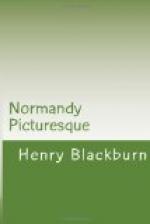Let us conclude our remarks on this subject with an extract from the published diary of a pedestrian, who thus describes his journey from Lisieux to Caen, a distance of about twenty-six miles:—
‘It is nightfall,’ he says, ’before I have walked more than half-way to Caen; to the left of the road I see a number of lights indicative of a small town, but I perceive no road in that direction, and so am compelled to trudge on. I was dreadfully fatigued, for I had walked about Lisieux before starting. In the faint light, I thought I saw a dog cross the road just before me, but soon perceived that it must be a spectral one, the result of excessive fatigue. At length I reach a lamp-post, with the light still burning, indicating that I am in the suburbs of Caen. The road proceeds down a steep hill. I don’t know how long it would seem to the visitor in the ordinary way, but to myself, prostrated by fatigue, it appeared on this night a long and weary tramp.’—’A Walking Tour in Normandy!’
CHAPTER XI.
ARCHITECTURE AND COSTUME.
In the course of our little pilgrimage through Normandy, it may have been thought that we dwelt with too much earnestness and enthusiasm on the architecture of the middle ages, as applicable to buildings in the nineteenth century. Let us repeat our belief, that it is in its adaptability to our wants, both practical and artistic, that its true value consists. Mediaeval architects in England are never tired of insisting upon this fact; although hitherto they must confess to a certain amount of failure, because, perhaps, they attempt too much.
If one were to judge by what appears to be going on in nearly every town in England at the present time, we should say that there never was a time when architecture was so much considered. ‘Every town’ (says a late writer, speaking of the extent of this movement), ’that shares the progress and character of the age, has a new town hall, a new exchange, new schools, and every institution for which an honest pretence can be found. A stranger, possessing an interest in the town, and with no claim upon it excepting that it shall please his eye, must be charmed with the profuse display of towers, turrets, pinnacles, and pointed roofs, windows of all sorts, niches, arcades, battlements, bosses, and everything else to be found in an architectural glossary. He may wonder why a lofty tower—sometimes several towers—should be necessary to the trying cases of assault and petty larceny, to the reading of newspapers, to the inspection of samples of wheat, or to the drilling of little boys in declensions and conjugations; but that is not his affair, and he has nothing to do with it, except to be thankful for a good sky-line, and a well-relieved, but yet harmonious, facade.’ Nevertheless, we live in certain hope of a more practical application of beauty and simplicity of form, to the wants and requirements of our own day; and we believe that it is possible to have both cheap and useful buildings, graceful in form, and harmonious in colour and design.




